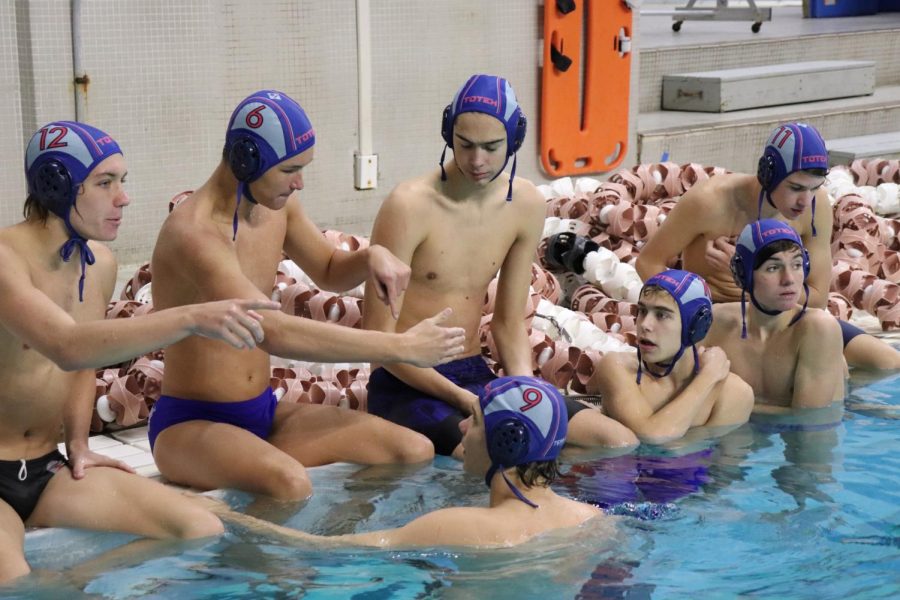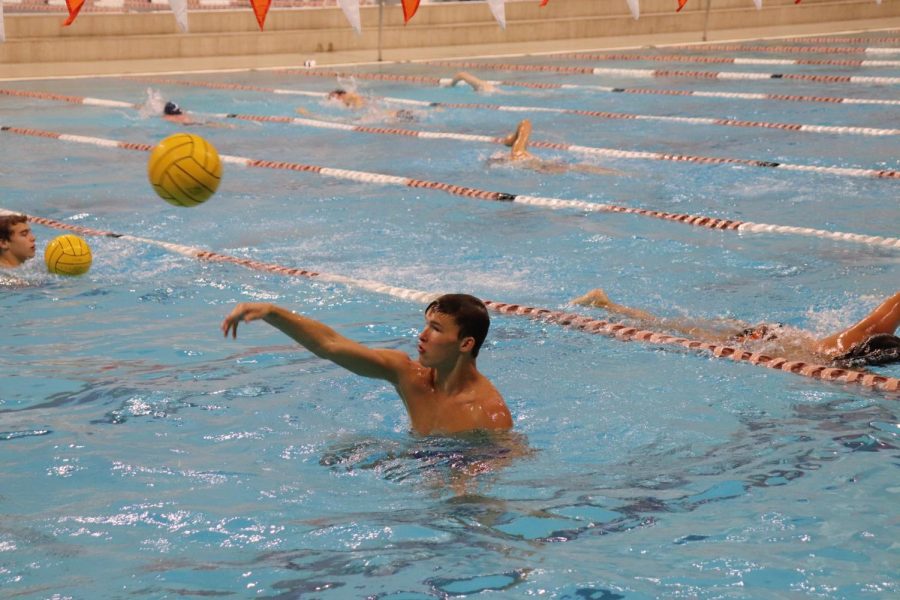PRINCE OF POLO: Senior Cole Kershner warms up during a water polo practice. “It takes a lot of stamina because you’re constantly sprinting back and forth, but I have pretty good stamina,” Kershner said. Photo by Gabby Sherwood.
Water polo captains know the score
When two seniors discovered that high school water polo was a thing, they brought the sport to Mac
Are you 6 feet tall and looking to score? There’s a group at McCallum in search of strong swimmers who can stay on a man. If you fit this description, and you’re wondering “Who wants me?” the Knights’ water polo team does.
The McCallum water polo team was created two years ago by the current captains, now seniors, Ivan Zaplatar and Cole Kershner, who are both competitive swimmers on the McCallum team. Kershner, along with swimming for McCallum, also played club water polo for Texas Longhorn Aquatics, or TXLA, in his free time. That’s when he realized that a water polo team was something that McCallum was lacking.
“I noticed a lot of other schools had teams,” Kershner said, “so I thought that we should have one too.”
Once the idea was there, the process of creating a new sports team that was recognized by the school didn’t require too many complex steps.
“I mean there’s some paperwork for getting a club,” Kershner said, “but that’s kind of it.”
After the official paperwork was accepted, the founders needed to find a faculty sponsor, a coach and players to fill out the roster.
The team is currently operating without a sponsor. According to Zaplatar, they are “beating the system” by doing so. Though there isn’t an official McCallum faculty sponsor, they do have a coach, Andrew Nagle, a University of Texas student whom the McCallum captains found through their connections to TXLA.

According to Kershner and Zaplatar, finding members for the team was the most time-consuming part, though it didn’t require too much strategy or effort.
“It was easy to build a good team,” Kershner said. “A lot of swimmers wanted to play.”
Water polo seems to be the natural next step for a McCallum swimmer wanting more from the pool. Most of the players on the team came from a swimming background, which makes sense since swimming is to water polo what running is to soccer.
While experienced swimmers are preferred, the team has always welcomed newcomers who are willing to learn.
“[In the beginning], we literally just walked around the school and asked people if they wanted to play water polo,” Zaplatar said, “and they were like ‘ya.’ Anyone can join. We are the most amazing people, and it’s a great environment. Everyone is there to have fun, and you get like an 80 percent chance to go to state and put it on your resume.”
Since the team practices every Thursday for two hours during their off-season and two to three hours nearly every day during their regular season, the novice members have plenty of time to get the feel of the game.
The rules of water polo are surprisingly simple. A game is played between two opposing teams of six.
The players are required to tread water for the entire game, avoiding touching the bottom of the pool. While swimming, players advance the ball by completing one-handed passes (touching the ball with both hands is a foul) to teammates or by “dribbling” with both the ball and the player’s head above the water.
The teams don’t have set positions except for the set, set D and goalie. The sets are the two players stationed in front of the goalie with the only difference being that set is for offense and set D is for defense.
These three players spend their time in front of the goal, a floating net that resembles a soccer or lacrosse goal only a little bit smaller, Zaplatar said. “It’s about six or seven feet, maybe eight. You just throw [the ball] in there, and you score. There’s a goalie that [tries to] block it too.”
According to both captains, scoring is the best part of the sport, but it comes at a price. Water polo is known for being a grueling sport for a reason. While one team is doing everything in its power to get the ball in the goal, the other team is doing everything in its power to stop them. If the referee can’t see what’s happening, then it’s legal (or at least unpunished) in the game.
Because what happens underwater is hard to monitor, fouling is common in water polo. The punishments vary based on the severity of the foul. If a defender fouls an offensive player within five meters of the goal and the foul prevents a likely goal, the offensive team is awarded a penalty shot from the 5-meter line.
“People are constantly on you,” Kershner said. “There’s always a lot of weight on you, and you have to be able to tread while someone is pressing on your shoulder. A lot of times, you’ll get injuries because people will kick you and a bunch of other [stuff]. People will punch you underwater too. It hurts if they’re close enough.”
Zaplatar agreed. “There’s a lot of [stuff]. It’s brutal—suit grabbing, punching under the water—you’ll get elbowed too and kicked. Kicking is the worst. One time I got kicked in the balls [when] we were in California for a tournament. I just started crying. I couldn’t play. It was terrible.”
The players established that playing water polo is both painful and tiring work, but for some reason, they keep coming back for more, trying to expand the program and leave their mark on the McCallum community.
“Water polo is just so fun,” Zaplatar said. “To me, it’s something different. It’s like a blend of sports. The best sports. We’re trying to expand and maybe make a girls team.”
The captain’s short-term goal is to be competitive in the pool and make a run at state. The long-term goal is to grow Knight water polo in involvement and in recognition so that the sport becomes established enough to stay afloat long after Kershner and Zaplatar are gone.
